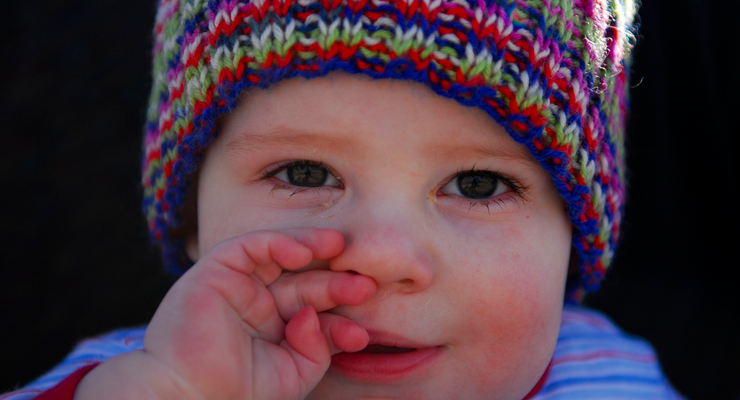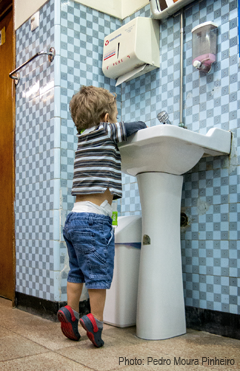I’m at that age where all my friends are having babies, lots of babies. At least every month I get a sweet card in the mail with pictures of their new families, and I place them on the refrigerator door along with the others.
And then something else happens, many of my friends and family start to ask me questions about what products they can buy that are safe(r) for baby. I decided it was time for us to create a tip sheet for new parents.
Twelve tips for new parents
1- Breathe and relax.
It’s overwhelming going to the store and trying to figure out which products are safe and which ones aren’t. There are many steps you can take to protect your family, but it’s not worth stressing yourself out to find “non-toxic perfection.” There is only so much you can do—try to be ok with that. Remember, it shouldn’t be up to you to find safe products for your family: Congress should pass strong laws on toxic chemicals to take this unnecessary burden off of your shoulders and retailers should start being a part of the solution.
2- Read labels of personal care products.
It’s important to note that personal care products, like cosmetics and shampoo, are required to label ingredients, but other product sectors aren’t. Avoid personal care products that have the following ingredients on the label:
- Triclosan, triclocarban, Microban™, Biofresh™
- Sythetic musks and fragrance
- Formaldehyde and releasing chemicals: DMDM Hydantoin, Quaternium 15 or Bronopol
- Parabens: which may appear as “___paraben” on the label
- Hydroquinone
- Nitrosamines
Check out this website for safer baby wipe suggestions.
3- Skip the hand sanitizer.
Many anti-bacteria soaps and hand sanitizers contain triclosan, a pesticide. Good ol’ soap and water is the most effective way to wash your hands, and if you’re in a pinch, use alcohol-based hand sanitizer. Some products like “moist towlettes” contain parabens, a preservative that has been linked to hormone-disruption. Sometimes the old-fashioned ways are the best.
4- Know your plastics.
Not all plastic is created equal. Avoid baby bottles, teething rings and toys that contain BPA and phthalates, two hormone-disrupting chemicals. Avoid PVC plastic (number 3 in the recycling arrow), also known as vinyl. PVC is one of the most toxic substances and causes health and environmental problems along its lifecycle. Skip vinyl lunch boxes, shower curtains etc.
Here is a great post from Nature Moms on natural and safer teething remedies.
5- Skip fragrance, cologne and scented laundry products.
Many fragrances contain dozens of toxic chemicals, and many contain the hormone-disrupting chemical phthalates. Skip the scented laundry detergent and fabric softener, unplug and remove air fresheners, and have the adults in the house avoid wearing fragrances. This is one of the most important things you can do to protect your family from toxic chemicals.
6- Shop for safe toys.
Shop for cloth, wool, felt, and wooden toys. Be mindful of the paint used on wooden toys, and avoid pressed wood products which may be treated with formaldehyde. Check out our report on toxic toys here and more gift ideas here.
7- Clean up household cleaners.
Many of the products we use to clean our home contain harmful chemicals that pollute indoor air and are bad for our health. Some companies sell safer, less toxic cleaning products. But often times the easiest way to clean your house is using vinegar, baking soda and a little elbow grease. Here are some cheap, homemade recipes.
8- Avoid toxic flame retardants.
Unfortunately many children’s products contain toxic flame retardants which have been linked to hormone disruption, cancer and harming the developing brain. Dust and vacuum frequently (be sure to get a vacuum with a HEPA filter), as dust is our primary route of exposure. For children, make sure they wash their hands before eating. Avoid purchasing children’s products made of polyurethane foam, commonly found in crib bumpers, crib mattresses, some nursing pillows and car seats.
9- Choose safer sunscreen.
It’s well established that using sunscreen can help reduce the risk of skin cancer, and painful sunburns! Unfortunately conventional sunscreens can contain chemicals that aren’t good for our health. Here are two resources for finding safer sunscreens for your family: 2013 safer sunscreen guide.
10 – Take baby steps.
There is no way you can or should try to overhaul your house in a week, trying to purge all toxic chemicals. Implement some of these tips slowly, and know that over time you’ll start to phase in safer products.
11- Help change our broken system.
If this is overwhelming, you’re not alone. Millions of Americans have joined our movement to strengthen and overhaul our weak federal laws on toxic chemicals. The government isn’t doing its job to protect us from toxic chemicals.
Please know that shopping is only a small part of the solution. We also need you to get involved and contact your Senators. Email them today to ask them to pass strong laws on toxic chemicals, so you don’t need to worry about all of this!
12- Ask retailers to do their part.
In addition to Congress updating our federal laws, retailers play an important role in moving the marketplace towards safer chemicals. Wouldn’t it be great if your favorite retailer agreed to move away from toxic chemicals? This would mean you could still get the products you love, but without all the nasty stuff. Tell retailers you expect them to take action on toxic chemicals.
Other resources:
- Top tips to protect your family from toxic chemicals – a great overview of tips to protect the whole family
- Healthy Stuff – a website full of product testing information and product ratings from cars, garden supplies, toys and car seats
- Guide for safer school supplies – ways to avoid PVC plastic
- Nine natural gift ideas for toddlers – from well-respected blogger, Good Girl Gone Green
- Safe Mama’s cheat sheets—this website is a wealth of information on safer product guides






